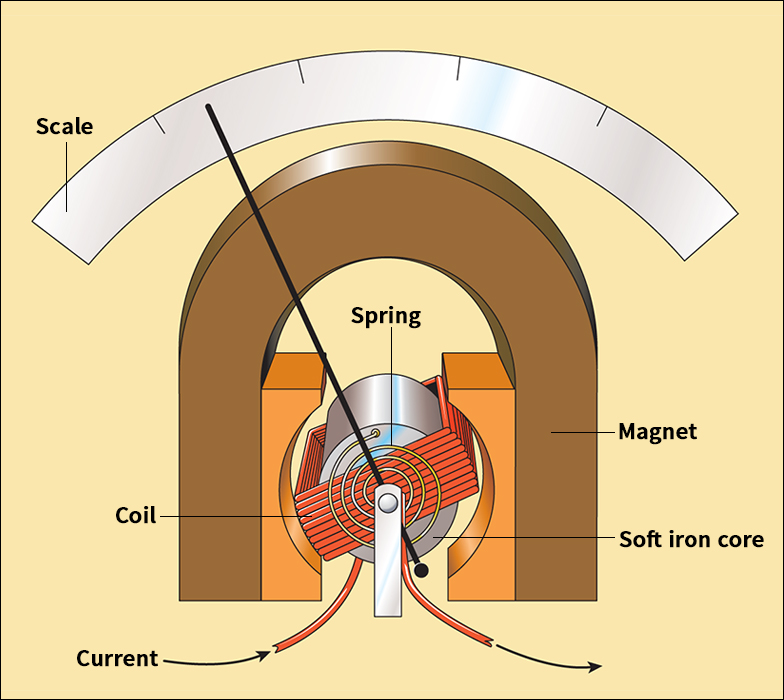Electric meter is the general name for a number of devices that measure various quantities related to electric energy. Examples of these quantities are voltage, current, power, and resistance (opposition to the flow of electric current). A meter that measures voltage is known as a voltmeter. One that measures current is called an ammeter— named after the unit of current, the ampere. A wattmeter measures power in watts, and an ohmmeter measures resistance in ohms. A meter that measures two or more electrical quantities is known as a multimeter. A multimeter usually has a multiple-position switch that enables the user to select the quantity to measure.
All electric meters have a device that senses either current or voltage. Various internal devices and methods of connection enable a meter to sense one quantity and display a measurement of another quantity—for example, to sense current and display power.
Most meters have two input terminals that are connected by wires to the circuit being measured. The way in which these wires are connected depends on what quantity is being measured.
Electric meters may be either analog or digital. Analog meters, the older type, make use of a moving pointer and a scale to display measured values. Digital meters use a numerical readout panel. Digital meters also differ from analog meters in that they have no internal moving parts. In addition, digital meters have much greater sensitivity in measuring than do analog meters.
Analog meters.
The main component of an analog electric meter is a coil of wire mounted inside a strong magnet. The coil rotates when an electric current passes through it, and the pointer turns with the coil. The angle to which the coil rotates is proportional to the amount of current flowing. This component can be used by itself to measure small currents. When used in this way, the component is known as a galvanometer.

Analog ammeters and voltmeters use a galvanometer as their main measuring element. Additional components inside the ammeter or voltmeter translate the current or voltage being measured into a current that the galvanometer can measure.
If a meter draws a large amount of current from the circuit being measured, it changes the quantity to be measured—thus producing an inaccurate result. But many people still use analog meters where extreme accuracy is not essential. In addition, workers often use an analog meter to measure a rapidly changing quantity. The meter is relatively easy to read as the pointer moves up and down the scale. It would be difficult to read the rapidly changing numbers of a digital meter.
Digital meters.
The heart of a digital electric meter is an integrated circuit called an analog-to-digital converter. This device compares the voltage being measured with a series of voltages stored in the chip’s memory. The chip quickly finds a voltage that is close to the voltage being measured. The chip then sends to the numerical readout panel a string of electric pulses that represent this voltage. Like an analog multimeter, a digital multimeter has additional components that enable it to measure a wide range of voltages and currents.
People generally prefer digital meters over analog meters of comparable cost for two reasons: (1) digital meters are more sensitive, and (2) they draw less current from the circuit being measured, and thus are more accurate. Inexpensive digital multimeters available at retail stores are extremely sensitive. They can measure voltages and currents roughly one-thousandth as strong as those produced by a small watch battery. Meters used in research laboratories can measure quantities a million times smaller than that.
Utility meters.
The most common electric utility meter found in many houses is a type of analog meter. This device measures the amount of electric energy supplied to the house. A worker for the local power company reads the meter at regular intervals, and the customer’s bill is based on these readings.
The utility meter is actually an electric motor that turns whenever current is flowing through the wires connecting the house to power lines. The rate at which the motor turns increases as the current supplied to the house increases. The shaft of the motor is connected, by a system of gears, to a counter that keeps track of the number of rotations of the shaft. The total number of rotations is proportional to the total amount of electric energy used by the customer. The counter scale and the display—usually four or five dials—therefore can be labeled in units of energy. The energy unit most commonly used by power companies is the kilowatt-hour. A kilowatt-hour is 1,000 watt-hours. A 100-watt light bulb left on for 10 hours will use 1 kilowatt-hour of electric energy.
Some modern utilities use special digital meters—often called _smart meters—_to gather energy usage information from their customers. These meters can communicate electronically with the utility and report such information many times each day.
History.
Hans Christian Oersted, a Danish physicist, investigated the effect of electric currents on a magnetic needle in 1820. Also in 1820, Johann Salomo Christoph Schweigger, a German physicist, built the first simple galvanometer. In 1882, Jacques Arsene d’Arsonval, a French medical researcher, greatly improved the performance of the galvanometer. The d’Arsonval galvanometer, the most common type of galvanometer, is named after him.
The American Oliver B. Shallenberger, then an electrical engineer with Westinghouse Electric Manufacturing Company, developed the first successful electric meter in 1888. In 1895, he patented an electric meter that became the basis for the electric utility meters used in most homes today.
